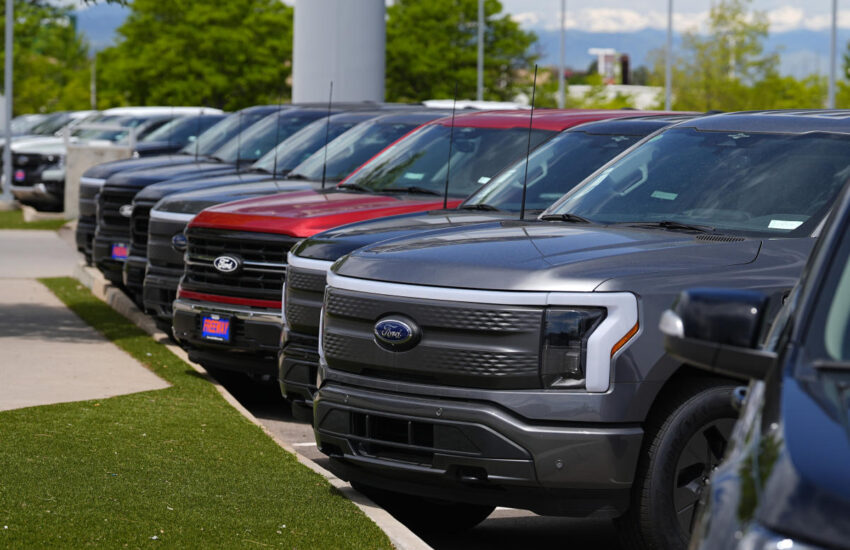[ad_1]
DETROIT (AP) – Investors punished auto stocks this week after second-quarter earnings reports exposed industry-wide problems of slowing sales and high prices, as companies they have to spend huge sums to make new electric and gas vehicles.
Each car company has unique problems, but common to many are increasing inventory of vehicles on dealer lots, which require increased discounts to sell to buyers with a stressed family budget.
Ford Motor Co., that he said a drop in second-quarter earnings due to electric vehicle losses and persistently high warranty costs led the declines. Its shares have fallen 20% this week. But others like General Motors, Tesla, Stellar and Nissanall have seen their shares drop about 8% or even more.
Carlos Tavares, CEO of Jeep and Ram maker Stellantis, said that a significant storm of the auto industry that he has been warning about for several years has arrived. “We’re in it,” he told reporters after releasing disappointing earnings on Thursday. “To me, it’s a no-brainer that this industry is going to be in turmoil.”
Shortly after the coronavirus pandemic spread around the world in 2020, car manufacturers had to slow down their factories due to a global shortage of computer chips. At the time, high-income buyers who couldn’t spend money on travel or restaurants began paying above sticker prices for a limited supply of loaded vehicles. Automakers have used their limited production to build only expensive things, and prices have risen nearly 27% from pre-pandemic levels.
The trend continued at the end of last year, with companies and dealers making big profits with lower sales than normal.
But as chip supplies have returned, automakers have ramped up production, and inventory at U.S. dealers’ lots has risen to about 1.8 million a year ago. Now it is just under 3 million, high, but still a million short of pre-pandemic numbers.
The problem for the industry is that it continued to build expensive vehicles loaded with options – while most high-income buyers had already bought new vehicles. The remaining buyers cannot afford much of what sellers have in stock because of high prices and interest rates. Now the big profits from expensive trucks and SUVs that paid to develop and build electric vehicles are starting to dwindle.
“It’s kind of ridiculous that anyone would have been surprised that this party was going to end,” said Sam Abuelsamid, principal mobility analyst for Guidehouse Insights. “There are only so many people who can afford such expensive vehicles, especially when interest rates have stayed as high as they have for so long.”
The average price of a new vehicle in the United States rose to $48,408 in December, according to data from Edmunds.com. It fell slightly to $47,616 last month. Discounts, which were minimal or nonexistent for the past few years, increased to an average of $1,819 per vehicle in June.
As the Federal Reserve raised interest rates, the average new auto loan rate jumped from a low of 4.1% in December 2021 to 7.3% last month. That increased the average monthly payment to $739 per month, with an average loan term of nearly six years, according to Edmunds.
The average price of used vehicles rose more than 50% from before the pandemic to a peak of $31,095 in April 2022. It decreased to $27,277 in June as new vehicle prices began to down, said Edmunds.
Stellantis’ earnings were crimped by a poor performance in North America. Tavares said the company’s prices are too high, causing potential buyers to leave showrooms without hearing about low-interest financing and other discounts.
“Our customers tell us they need more accessibility,” he said.
Such requests have put Stellantis in a tight spot between offering lower prices, and inflationary pressures on the business, Tavares said. Stellantis, he said, must cut costs to preserve profit margins at lower prices – something that all automakers are now facing.
“We need attractive products, high-quality products at a competitive cost that protects the affordability that makes customers buy our products,” Tavares said.
Tavares predicted that the industry storm could last several years, and could cause some automakers to fail.
Automakers, notably GM, Ford and Stellantis, abandoned lower-priced small and even midsize cars starting five or six years ago, leaving little to sell to those who want affordable vehicles, Abuelsamid said. said Some, like GM, still offer affordable smaller SUVs. But those who don’t have affordable vehicles now are likely to struggle more than their competitors, he said.
Industry analysts expect more discounts from automakers and possible interest rate cuts from the US Federal Reserve later this year and into next year. So for those who can, it might be wise to wait before buying a new or used vehicle, said Eric Lyman, vice president of products at Black Book, which tracks auto prices.
“Savvy buyers would be wise to put their vehicle purchase search on hold until we see further declines in used and new vehicle prices, as well as the much-anticipated decline in interest rates, for address the affordability crisis we’re in,” Lyman said.
